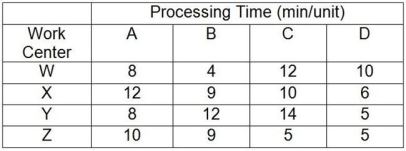Table 5.2
A company makes four products that have the following characteristics: Product A sells for $75 but needs $20 of materials and $20 of labor to produce; Product B sells for $90 but needs $45 of materials and $20 of labor to produce; Product C sells for $110 but needs $50 of materials and $30 of labor to produce; Product D sells for $135 but needs $75 of materials and $40 of labor to produce. The processing requirements for each product on each of the four machines are shown in the table.

Work centers W, X, Y, and Z are available for 40 hours per week and have no setup time when switching between products. Market demand is 50 As, 60 Bs, 70 Cs, and 80 Ds per week. In the questions that follow, the traditional method refers to maximizing the contribution margin per unit for each product, and the bottleneck method refers to maximizing the contribution margin per minute at the bottleneck for each product.
-Use the information in Table 5.2. Using the traditional method, what is the profit if the company manufactures the optimal product mix (consider variable costs only-overhead is not included in this profit calculation) ?
Definitions:
Hippocampal Formation
A complex brain structure embedded deep into the temporal lobe, playing a major role in learning and memory.
Caching Food
The behavior of storing away food in hidden locations by animals, as a strategy to manage food supply.
Neuritic Plaques
Accumulations of amyloid beta proteins found in the brains of Alzheimer's disease patients, contributing to neurodegeneration.
Q42: The underlying statistical distribution for the p-chart
Q46: The project manager and team can step
Q51: Just-in-time (JIT) systems need close relationships with
Q51: The notion of internal customers applies to
Q82: Which one of the following factors usually
Q88: Line balancing strives to create workstations so
Q131: What is the critical path for the
Q138: The upper and lower specifications for a
Q169: Increasing the quality level by better products
Q193: The upper and lower specification limits for